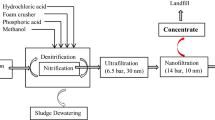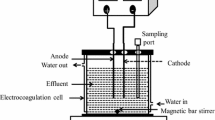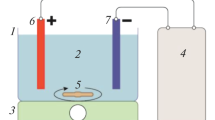Abstract
The present study aims to investigate the treatment of leachate by the electrocoagulation (EC) process using aluminum electrodes. A response surface methodology (RSM)-based central composite design (CCD) was carried out to design the experiments, develop a statistical model, assess the relationship between the four variables, and predict the responses, namely, the chemical oxygen demand (COD). The removal efficiency of COD, biological organic matter (BOD5), and turbidity were about 90%, 92.3%, and 99.6%, respectively, under optimum operational conditions, i.e., initial pH (5.3), current intensity (1.2 A), electrolysis time (75 min), and stirring speed (150 rpm). The operating cost of the current EC treatment was 0.6 €/m3. Moreover, the coefficient of determination (R2) revealed a satisfactory agreement between observed and expected results. Therefore, RSM is an appropriate approach to determine the key parameters for electrocoagulation process.










Similar content being viewed by others
Data Availability
The authors confirm that the data supporting the findings of this study are available within the article and its supplementary information files.
References
Li, X., Song, J., Guo, J., Wang, Z., & Feng, Q. (2011). Landfill leachate treatment using electrocoagulation. Procedia Environmental Sciences, 10, 1159–1164.
Fernandes, A., Pacheco, M. J., Ciriaco, L., & Lopes, A. (2015). Review on the electrochemical processes for the treatment of sanitary landfill leachates: present and future. Applied Catalysis B: Environmental, 176, 183–200.
Boumechhour, F., Rabah, K., Lamine, C., & Said, B. M. (2012). Treatment of landfill leachate using Fenton process and coagulation-flocculation. Water Environ. J., 27(1), 114–119.
Smaoui, Y., Chaabouni, M., Sayadi, S., & Bouzid, J. (2016). Coagulation flocculation process for leachate pretreatment and optimization with response surface methodology. Desalination and Water Treatment, 57(31), 14488–14495.
Asaithambi, P., Beyene, D., Abdul Aziz, A. R., & Alemayehu, E. (2018). Removal of pollutants with determination of power consumption from landfill leachate wastewater using an electrocoagulation process: optimization using response surface methodology (RSM). Applied Water Science, 8(2), 69.
Bouhezila, F., Hariti, M., Lounici, H., & Mameri, N. (2011). Treatment of the OUED SMAR town landfill leachate by an electrochemical reactor. Desalination, 280(1–3), 347–353.
Pooja, G. S., & Indu, S. T. (2014). Enhanced removal of COD and color from landfill leachate in a sequential bioreactor. Bioresource Technology, 170, 10–19.
Ghanbari, F., & Moradia, M. (2014). Application of response surface method for coagulation process in leachate treatment as pretreatment for Fenton process: Biodegradability improvement. Journal of Water Process Engineering, 4, 67–73.
APHA/AWWA/WEF. (1998). Standard Methods for the Examination of Water and Wastewater, 20th, ed. The Public Health Association, Washington, DC. USA.
Chattoraj, S., Mondal, N. K., Das, B., Roy, P., & Sadhukhan, B. (2014). Biosorption of carbaryl from aqueous solution onto Pistia stratiotes biomass. Applied Water Science, 4(1), 79–88.
Ponnusami, V., Krithika, V., Madhuram, R., & Srivastava, S. N. (2007). Biosorption of reactive dye using acid-treated rice husk: factorial design analysis. Journal of Hazardous Materials, 142(1–2), 397–403.
Ghafari, S., Aziz, H. A., Isa, M. H., & Zinatizadeh, A. (2009). Application of response surface methodology (RSM) to optimize coagulation-flocculation treatment of leachate using poly-aluminum chloride (PAC) and alum. Journal of Hazardous Materials, 163(2–3), 650–656.
Sharma, A. K., & Chopra, A. K. (2017). Removal of nitrate and sulphate from biologically treated municipal wastewater by electrocoagulation. Applied Water Science, 7(3), 1239–1246.
Thuy, K., & Lim, K. (2011). Response surface methodological approach to optimize the coagulation-flocculation process in drinking water treatment. Chemical Engineering Research and Design, 89(7), 1126–113.
Karichappan, T., Venkatachalam, S., & Jeganathan, P. M. (2014). Optimization of electrocoagulation process to treat grey wastewater in batch mode using response surface methodology. Journal of Environmental Health Science & Engineering, Engineering, 12(1), 29.
Gengec, E., Kobya, M., Demirbas, E., Akyol, A., & Oktor, K. (2012). Optimization of baker’s yeast wastewater using response surface methodology by electrocoagulation. Desalination, 286, 200–209.
Ye, J., Zhang, P., Hoffmann, E., Zeng, G., Tang, Y., Dresely, J., & Liu, Y. (2014). Comparison of response surface methodology and artificial neural network in optimization and prediction of acid activation of Bauxsol for phosphorus adsorption. Water, Air, & Soil Pollution, 225(12), 2225.
Dia, O., Drogui, P., Buelna, G., Dube, R., & Ihsen, B. S. (2017). Electrocoagulation of biofiltrated landfill leachate. Fractionation Org. matter Influ. Anode Material, 168, 1136–1141.
Huda, N., Raman, A. A. A., Bello, M. M., & Ramesh, S. (2017). Electrocoagulation treatment of raw landfill leachate using iron-based electrodes: Effects of process parameters and optimization. Journal of Environmental Management, 204, 75–81.
Guesmi, F., Louati, I., Hannachi, C., & Hamrouni, B. (2016). Comparison of adsorption models for the removal of fluorides, nitrates and sulfates by adsorption onto AFN membrane. Water Quality Research Journal of Canada, 51(2), 106–116.
Ogedey, A., & Tanyol, M. (2017). optimizing electrocoagulation process using experimental design for COD removal from unsanitary landfill leachate. Water Science and Technology, 76(11), 2907–2917.
Djafarzadeh, N., Safarpour, M., & Khataee, A. (2014). Electrochemical degradation of three reactive dyes using carbon paper cathode modified with carbon nanotubes and their simultaneous determination by partial least square method. Korean Journal of Chemical Engineering, 31(5), 785–793.
Kobya, M., Demirbas, E., Bayramoglu, M., & Sensoy, M. T. (2011). Optimization of electrocoagulation process for the treatment of metal cutting wastewaters with response surface methodology. Water, Air, & Soil Pollution, 215(1–4), 399–410.
Güçlü, D. (2015). Optimization of electrocoagulation of pistachio processing wastewaters using the response surface methodology. Desalination and Water Treatment, 54(12), 3338–3347.
Hanafi, F., Assobhei, O., & Mountadar, M. (2010). Detoxification and discoloration of Moroccan olive mill wastewater by electrocoagulation. Journal of Hazardous Materials, 174(1–3), 807–812.
Holt, P. H., Barton, G. W., Wark, M., & Mitchell, A. A. (2002). A quantitative comparison between chemical dosing and electrocoagulation. Colloids and Surfaces A: Physicochemical and Engineering Aspects, 211(2–3), 233–248.
Tak, B. Y., Tak, B., Kim, Y. J., Park, Y. J., Yoon, Y. H., & Min, G. H. (2015). Optimization of color and COD removal from livestock wastewater by electrocoagulation process: Application of Box-Behnken design (BBD). Journal of industrial and engineering chemistry, 28, 307–315.
Thirugnanasambandham, K., Sivakumar, V., & Maran, P. J. (2014). Efficiency of electrocoagulation method to treat chicken processing industry wastewater-modeling and optimization. Journal of the Taiwan Institute of Chemical Engineers, 45(5), 2427–2435.
Katal, R., & Pahlavanzadeh, H. (2011). Influence of different combinations of aluminum and iron electrode on electrocoagulation efficiency: application to the treatment of paper mill wastewater. Desalination, 265(3), 199–205.
Manoj, P., Wagh, P., & Nemade, D. (2015). Treatment of distillery spent wash by using chemical coagulation (CC) and electro – coagulation. American Journal of Environmental Protection, 3(5), 159–163.
Veli, S., Arslan, A., & Bingöl, D. (2016). Application of response surface methodology to electrocoagulation treatment of hospital wastewater. Clean-Soil Air Water, 44(11), 1516–1522.
Vlyssides, A. G., Karlis, P. K., & Mahnken, G. (2003). Influence of various parameters on the electrochemical treatment of landfill leachates. Journal of Applied Electrochemistry., 33(2), 155–159.
Myers, R. H., & Montgomery, D. C. (2002). Response Surface Methodology: Process and Product Optimization Using Designed Experiments (2nd ed.). USA: John Wiley & Sons.
Kabuk, H. A., İlhan, F., Avsar, Y., Kurt, U., Apaydin, O., & GonulluT. , M. (2013). Investigation of leachate treatment with electrocoagulation and optimization by response surface methodology. Clean-Soil Air Water, 1(9999), 1–7.
Acknowledgements
The authors present their recognition to the head of the Process Engineering department of the Faculty of Applied Sciences, UKM Ouargla, for his corporation. The authors are also grateful to Pr. Dr. Toudert Ahmed Zaid (Department of Chemical Engineering, National polytechnic school, Algiers, Algeria) for his guidance and valuable advice. We thank the anonymous reviewers whose corrections and constructive suggestions have significantly increased the overall quality of the manuscript.
Author information
Authors and Affiliations
Contributions
R Lessoued wrote the paper, designed experiments, performed the statistical analysis, and participated in the interpretation of the data. Baameur and A Tabchouche contributed to the analysis of the results, helped to draft the manuscript, and participated in its revisions. All authors read and approved the final manuscript.
Corresponding author
Ethics declarations
Conflict of Interest
The authors declare that they have no conflict of interest.
Additional information
Publisher's Note
Springer Nature remains neutral with regard to jurisdictional claims in published maps and institutional affiliations.
Rights and permissions
About this article
Cite this article
Lessoued, R., Baameur, L. & Tabchouche, A. Modeling and Optimization of COD Removal from Leachate by Electrocoagulation: Application of Central Composite Design. Environ Model Assess 26, 423–432 (2021). https://doi.org/10.1007/s10666-021-09765-7
Received:
Accepted:
Published:
Issue Date:
DOI: https://doi.org/10.1007/s10666-021-09765-7




